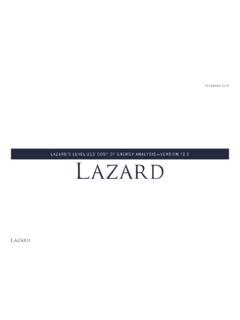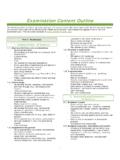Transcription of Disqualified Corporate Interest Expense Disallowed Under ...
1 Userid: CPMS chema: instrxLeadpct: 100%Pt. size: Draft Ok to PrintAH XSL/XMLF ileid: .. ns/I8926/201712/A/XML/Cycle05/source(Ini t. & Date) _____Page 1 of 3 8:59 - 9-Nov-2017 The type and rule above prints on all proofs including departmental reproduction proofs. MUST be removed before for Form 8926(Rev. December 2017) Disqualified Corporate Interest Expense Disallowed Under Section 163(j)and Related InformationDepartment of the TreasuryInternal Revenue ServiceSection references are to the Internal Revenue Code unless otherwise DevelopmentsFor the latest information about developments related to Form 8926 and its instructions, such as legislation enacted after they were published, go to InstructionsPurpose of FormCorporations use Form 8926 to figure the amount of any Corporate Interest Expense deduction Disallowed by section 163(j). A corporation's Interest Expense deduction may be Disallowed if it paid or accrued Disqualified Interest during the tax year.
2 However, if at least one of the following statements is true, Disqualified Interest which the corporation has actually paid or accrued in the current tax year will not be Disallowed by section 163(j).The corporation's debt to equity ratio at the end of the tax year does not exceed to corporation does not have any excess Interest Expense for the tax also use Form 8926 to figure the amount of any Interest Expense deduction Disallowed by section 163(j) for a previous tax year that is allowed for the current tax Must FileA corporation (other than an S corporation) must complete and file Form 8926 if it paid or accrued Disqualified Interest during the current tax year or had a carryforward of Disqualified Interest from a previous tax year. A corporation must complete and file Form 8926 even if it meets the debt-to-equity safe harbor of section 163(j)(2)(A)(ii). Disqualified InterestDisqualified Interest is: Interest paid or accrued (directly or indirectly) to a related person not subject to income tax on the Interest , Interest paid or accrued on indebtedness held by an unrelated person if there is a Disqualified guarantee of the indebtedness and the Interest is not subject to a gross basis income tax (a tax figured on the gross amount of an item of income without reduction for any allowed deduction), andInterest paid or accrued (directly or indirectly) to a taxable real estate investment trust (as defined in section 856(l)) by a subsidiary of the , any Disqualified Interest Disallowed as a deduction by section 163(j) in a tax year is carried forward and treated as Disqualified Interest paid or accrued in the next tax PersonA related person is a person who is related to the corporation Under sections 267(b) or 707(b)(1).
3 For this purpose, the attribution rules of section 267(c) apply. In determining whether persons are related, the substance of ownership, rather than its form, determine relatedness as of the date on which an item of Interest Expense accrues. Consequently, changes in the relationship between the payor corporation and the payee after the accrual date are A partnership is not a related person if less than 10% of the profits and capital Interest in the partnership are held by partners not subject to income tax on the Interest . However, the partners may be related a treaty between the United States and a foreign country reduces the rate of income tax imposed on a partner's share of any Interest paid or accrued to a partnership, that partner's interests in the partnership are treated as held in part by a person subject to and in part by a person not subject to income tax on the this situation, figure the Interest treated as held by a partner not subject to income tax by multiplying the Interest by:The rate of tax imposed without regard to the treaty, reduced by the rate of tax imposed by the treaty, divided byThe rate of tax imposed without regard to the EntitiesIn the case of any Interest paid or accrued to a partnership, the determination of whether any tax is subject to income tax is made at the partner level.
4 A similar rule applies in the case of other pass-through entities and in the case of tiered partnerships and other a treaty between the United States and a foreign country reduces the rate of income tax imposed on the Interest paid or accrued to a person, the Interest is treated as paid or accrued in part to a person subject to and in part to a person not subject to income tax on the this situation, figure the Interest treated as paid or accrued to a person not subject to income tax on the Interest by multiplying the Interest by:The rate of tax imposed without regard to the treaty, reduced by the rate of tax imposed by the treaty, divided byThe rate of tax imposed without regard to the GuaranteeA guarantee includes any arrangement Under which a person (directly or indirectly through an entity or otherwise) assures, on a conditional or unconditional basis, the payment of another person's obligation Under any Disqualified guarantee is generally a guarantee by a related person that is a tax-exempt organization or a foreign person, unless the corporation owns a controlling Interest in the tax-exempt organization or foreign this purpose, a controlling Interest is direct or indirect ownership of at least 80% of the total voting power and value of all classes of stock of a corporation, or 80% of the profit and capital interests in any other entity.
5 For this purpose, the rules of paragraphs (1) and (5) of section 267(c) apply to both corporations and entities other than 09, 2017 Cat. No. 51518 BPage 2 of 3 Fileid: .. ns/I8926/201712/A/XML/Cycle05/source8:59 - 9-Nov-2017 The type and rule above prints on all proofs including departmental reproduction proofs. MUST be removed before GroupsAll members of an affiliated group (described in section 1504(a)) are treated as one of Debt to EquityA corporation's ratio of debt to equity is the ratio of the total indebtedness that the corporation bears to the sum of its money and the adjusted basis of all other assets reduced (but not below zero) by the total indebtedness. For this purpose, use the adjusted basis that would be used to determine gain. Also, for indebtedness with original issue discount (OID), use its issue price plus the portion of the OID previously accrued as determined Under the rules of section 1272 (determined without regard to section 1272(a)(7) or (b)(4)).
6 Indebtedness. Debt is determined in accordance with generally applicable tax principles. Thus, in general, a contingent liability for financial accounting purposes that has not accrued for tax purposes will not be treated as a liability for purposes of section 163(j).Net Interest ExpenseA corporation's net Interest Expense is the excess (if any) of:The Interest paid or accrued by the corporation during the tax year, overThe Interest includible in the gross income of the corporation for the tax Interest ExpenseA corporation's excess Interest Expense is the excess (if any) of:The corporation's net Interest Expense , overThe sum of 50% of the adjusted taxable income of the corporation plus any excess limitation corporation's excess limitation is the excess (if any) of:50% of the adjusted taxable income of the corporation, overThe corporation's net Interest excess limitation in a tax year is treated as an excess limitation carryforward to the first following tax year and, if unused in that tax year, similarly carried forward to the second and third following tax years.
7 However, the carryforward that can be used in each of the following tax years cannot exceed the excess Interest Expense for that tax year (figured without the use of any excess limitation carryforward). Corporate PartnersIf a corporation owns (directly or indirectly) an Interest in a partnership, the following rules corporation's distributive share of Interest income paid or accrued to the partnership is treated as Interest income paid or accrued to the corporation's distributive share of Interest paid or accrued by the partnership is treated as Interest paid or accrued by the corporation's share of the liabilities of the partnership is treated as liabilities of the Activity and At-Risk RulesSection 163(j) is applied before the passive activity and at-risk Interest LimitationsOther sections limiting the deductibility of Interest , such as sections 267(a)(3) and 163(e)(3), apply before section 163(j).Specific InstructionsAffiliated Group CheckboxA single form must be filed for all members of an affiliated group as defined in section 163(j)(6)(C), including those that are not members of the same consolidated 1dEnter the total amount of the corporation's indebtedness as of the last day of the tax year.
8 Enter all indebtedness owed to related parties and all indebtedness owed to third parties. For more information, see Ratio of Debt to Equity, 1f. Debt to Equity RatioDivide line 1d by line the total amount of the corporation's indebtedness as of the last day of the tax year by the sum of money and adjusted basis of all the corporation's other assets reduced by the total the results as a decimal (rounded to five decimal places).Example 1. Corporation A is a calendar year corporation. At the end of 2017, Corporation A's money totaled $300,500. The adjusted basis of the corporation's other assets totaled $574,500. Corporation A's total indebtedness at the end of 2017 is $525,000. The debt to equity ratio for Corporation A is 1:Money ..$300,500 Plus: Adjusted basis of all other assets ..574,500 Total ..$875,000 Minus: Total indebtedness ..525,000 Corporation A's equity ..$350,000 Calculation of Corporation A's debt to equity ratio:Corporation A's total $525,000 Divided by: Corporation A's ,000 Corporation A's debt to equity ratio (Form 8926, line 1f).
9 Since the debt to equity ratio does not exceed to 1, Disqualified Interest paid or accrued in the current tax year will not be Disallowed by section 163(j).Example 2. Corporation B is a calendar year corporation. At the end of 2017, Corporation B's money totaled $400,000. The adjusted basis of the corporation's other assets totaled $599,950. Corporation B's total indebtedness at the end of 2017 is $600,020. The debt to equity ratio for Corporation B is 2:Money ..$400,000 Plus: Adjusted basis of all other assets ..599,950 Total ..$999,950 Minus: Total indebtedness ..600,020 Corporation B's equity ..$399,930 Calculation of Corporation B's debt to equity ratio:Corporation B's total $600,020 Divided by: Corporation B's ,930 Corporation B's debt to equity ratio (Form 8926, line 1f) .. Since the debt to equity ratio exceeds to 1, Disqualified Interest paid or accrued in the current tax year will be Disallowed by section 163(j) to -2-Page 3 of 3 Fileid.
10 Ns/I8926/201712/A/XML/Cycle05/source8:59 - 9-Nov-2017 The type and rule above prints on all proofs including departmental reproduction proofs. MUST be removed before extent of the corporation's excess Interest Expense for the tax 1iEnter all assets that are directly owned by the corporation, including assets held through a partnership or Partnerships and simple trusts are treated as 2aInterest paid or accrued by the corporation for the tax year includes any Disqualified Interest Disallowed Under section 163(j) in a previous year which has been carried forward to the current tax 3bInclude only the allowable net Interest Expense on line 3b to determine adjusted taxable income. Do not include the following Interest on line 3b, unless such amounts were deducted in determining taxable income on line Interest that the corporation paid or accrued but was not allowed to claim as an Interest Expense deduction Under another code Disqualified Interest Disallowed Under section 163(j) in a previous year which has been carried forward to the current tax 3fEnter any additional adjustments the corporation has made to its taxable income (loss) in arriving at its adjusted taxable income Under section 163(j)(6).
















